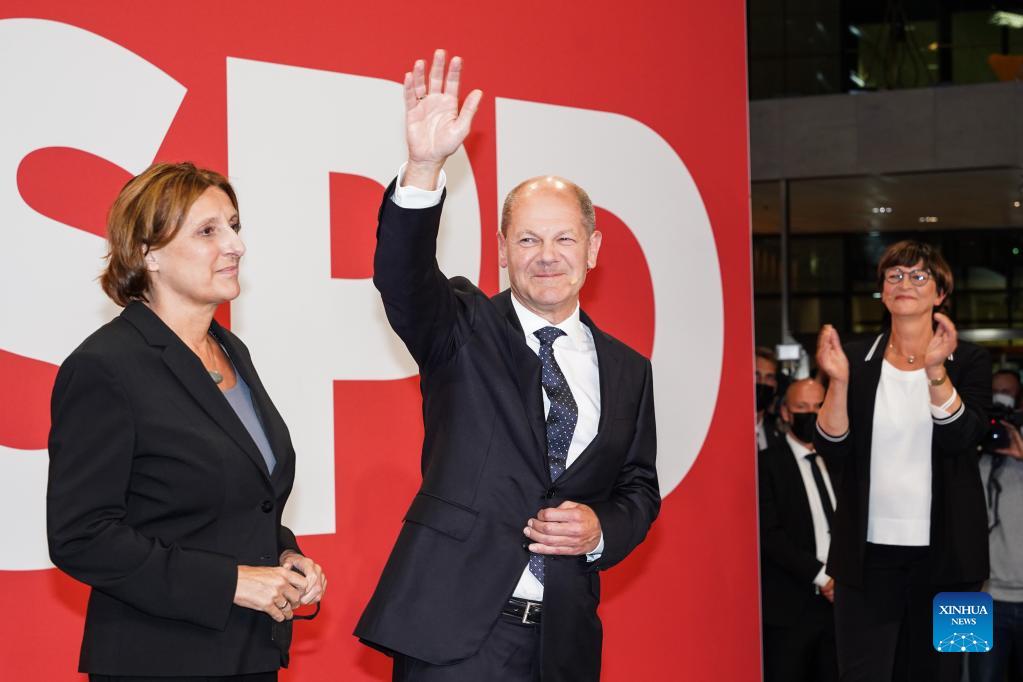
Chancellor candidate of Germany’s Social Democratic Party (SPD) Olaf Scholz
BERLIN, Sept 27 (NNN-Xinhua) — Germany’s center-left Social Democratic Party (SPD) slightly led in the federal election on Sunday, while its major competitor plunged to a record low after 16 years in office of Chancellor Angela Merkel, according to projections by German public broadcasters.
Projections by public broadcasters ARD and ZDF showed that SPD won 24.9 to 25.6 percent of the votes, based on different polling institutions. The conservative union of Christian Democratic Union (CDU) and its sister party Christian Social Union (CSU) fell to 24.4 to 24.7 percent.
The results are so tight that both parties believe that they could lead the new federal government.
Olaf Scholz, SPD’s chancellor candidate who is also incumbent vice-chancellor and finance minister, received long-time applause from his party on his first public appearance in SPD’s headquarters in Berlin after the projections were released.
“I’m happy to see so many here and of course I’m happy about the election result … Many citizens want that the next Chancellor is Olaf Scholz,” he said.
“It’s a head-to-head race,” said Armin Laschet, minister-president of Nord Rhein-Westphalia and CDU chairman.
“This election evening is an exceptional situation. We don’t have any reliable figures at the moment — but we can already say that we cannot be satisfied with this result,” said Laschet, adding that the CDU/CSU union saw a clear mandate to form the next government.
The election is of great significance as Merkel will retire after the new government is formed, and Germany will see a new head of government after almost 16 years.
The power transition in Germany will not only impact on its domestic issues like taxes, energy transition and climate protection but also affect its European policies as well as Berlin’s positioning in world politics, according to analysts.
The result projections also showed that the next German federal government is likely to be an unprecedented three-party coalition in the post-war period.
Other smaller parties, including the environmental and climate protection-oriented Greens and pro-business Free Democratic Party (FDP), have great opportunities to become ruling parties while there are also several possibilities to form the coalition, analysts predicted.
With Annalena Baerbock as chancellor candidate, the Greens garnered 14.6 to 14.7 percent votes, and the FDP 11.7 percent. The right-wing Alternative for Germany (AfD) won 10.3 to 11.1 percent of votes. The leftist Die Linke had only five percent, the hurdle for entering the Bundestag.
The next federal government will be formed through coalition negotiations, which will sometimes take months to finish.
Laschet told a televised debate on ARD and ZDF later on Sunday that he wanted to get it done by Christmas at the latest, and Scholz echoed his main rival by saying that he wanted the negotiations on forming a new government to be speedy.
“My wish is to get over it quicker. It would be absurd to name a date. But it would be good if it were over by Christmas,” Scholz said.
In the last Bundestag election in 2017, the CDU/CSU union secured 33 percent of the vote, while the SPD took only 20.5 percent.
This year, around 60.4 million people are eligible to vote in Germany, and the country is divided into 299 electoral districts.
According to official statistics, voter turnout of Sunday’s general election directly in polling stations stood at 36.5 percent by 2 p.m. local time (1200 GMT), slightly lower than the 41.1 percent at the same time in 2017.
“The voter turnout now determined is lower than in 2017, as was expected, because we expect a markedly higher share of postal voters. Their voter turnout will be calculated later when determining the final election result,” said Federal Returning Officer Georg Thiel. — NNN-XINHUA





